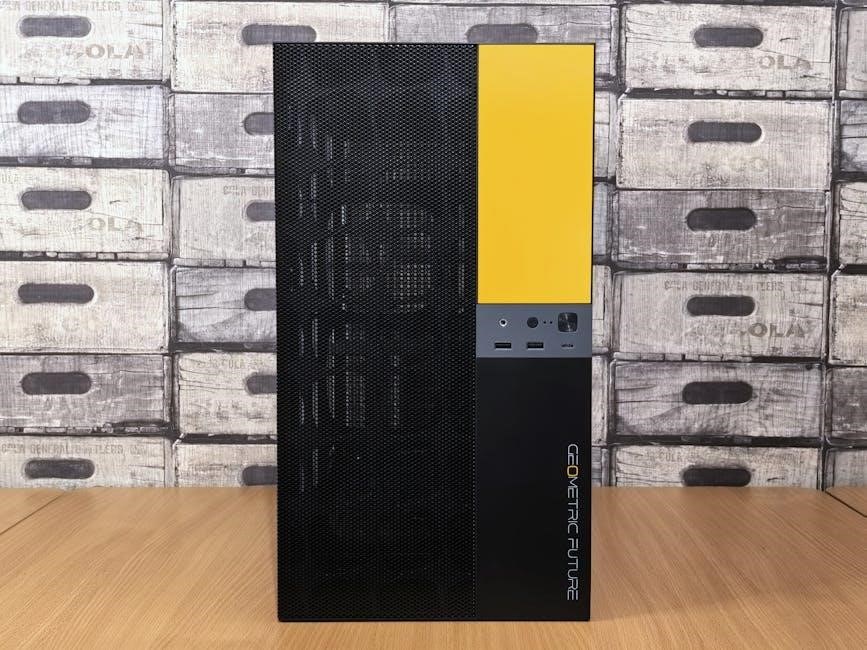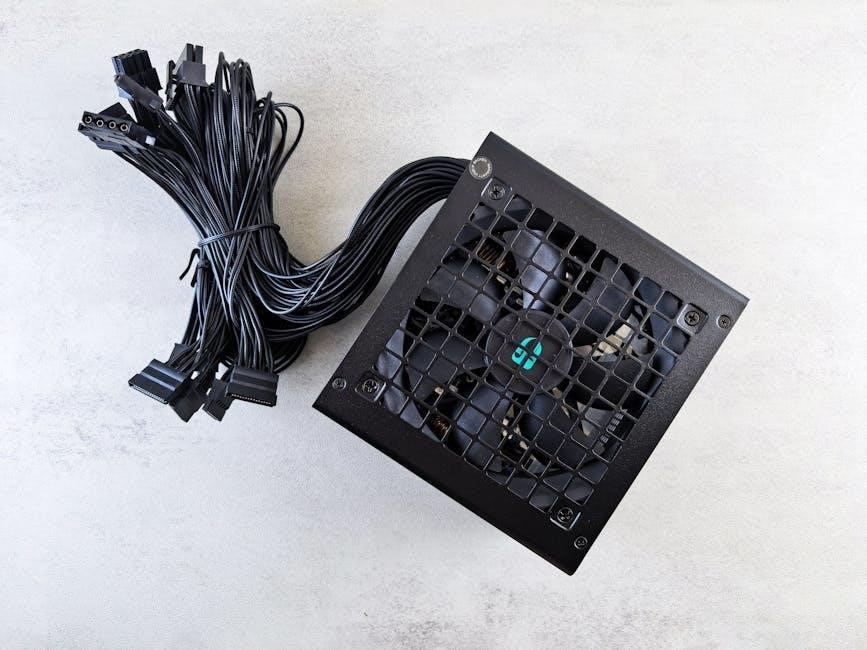The HPE 450e Tower Desktop PC is a powerful, flexible system designed to meet the needs of both businesses and specialists, offering high performance, reliability, and adaptability.
1.1 Overview of the HPE 450e Tower Desktop PC
The HPE 450e Tower Desktop PC is a robust and adaptable system, engineered to deliver high performance and reliability for businesses and professionals. Its flexible design supports various workloads, making it ideal for demanding tasks. With scalable hardware options, it ensures long-term efficiency and meets the evolving needs of users seeking a dependable computing solution.
1.2 Key Features and Benefits
The HPE 450e Tower Desktop PC boasts robust processing power, ample storage options, and versatile connectivity. It features high-efficiency cooling, ensuring optimal performance under intensive workloads. With enhanced security features and easy expandability, it offers a reliable and future-proof solution for both professional and business environments, catering to diverse computing needs effectively.
1.3 Target Audience and Use Cases
The HPE 450e Tower Desktop PC is ideal for small to medium businesses, remote workers, and educational institutions. It excels in office applications, multitasking, and content creation. Suitable for both home and professional environments, it supports demanding tasks like video editing and data management, making it a versatile choice for a wide range of users and workflows.

System Specifications and Hardware Components
The HPE 450e features Intel Core processors, up to 64GB DDR4 memory, SATA storage options, integrated graphics, and comprehensive networking capabilities, ensuring reliability and scalability for business needs.
2.1 Processor and Memory Options
The HPE 450e supports Intel Core i5 and i7 processors, offering quad-core and multi-threading capabilities. Memory options range from 4GB to 64GB DDR4, with dual-channel support for enhanced performance. Configurations can include ECC memory for added reliability, making it suitable for demanding tasks and ensuring smooth multitasking in business environments.
2.2 Storage Options and Configurations
The HPE 450e supports a range of storage solutions, including HDDs up to 2TB and SSDs for faster access. It also offers NVMe SSD options for high-performance needs. Configurations can include single or multiple drives, with RAID support for redundancy and improved data security. This flexibility ensures scalable storage solutions tailored to specific business requirements and workflows.
2.3 Graphics and Display Capabilities
The HPE 450e offers integrated Intel UHD Graphics for reliable performance and supports optional discrete GPUs for enhanced visuals. It can drive up to three monitors simultaneously, enabling multitasking efficiency. With HDMI and VGA ports, it ensures compatibility with modern and legacy displays, delivering crisp visuals for professional applications, video conferencing, and everyday productivity.
2.4 Networking and Connectivity Features
The HPE 450e includes a Gigabit Ethernet port for high-speed wired connections and supports optional Wi-Fi adapters for wireless convenience. It features multiple USB 3.2 ports for peripherals, an HDMI port for displays, and a PCIe slot for expansion. These connectivity options ensure seamless integration with networks, devices, and accessories, catering to both wired and wireless workplace requirements efficiently.

Setting Up Your HPE 450e Tower Desktop PC
This section guides you through the process of unboxing, physical installation, and initial setup of your HPE 450e Tower Desktop PC for a smooth and efficient experience.
3.1 Unboxing and Physical Installation
Begin by carefully unboxing the HPE 450e Tower Desktop PC, ensuring all components are accounted for. Inspect for damage and handle the system by the chassis to avoid static discharge. Place the tower on a stable, well-ventilated surface. Install the stand if required, and position the PC securely. Connect the power cord and essential cables, ensuring proper alignment and tight connections to prevent loose links.
3.2 Connecting Peripherals and Cables
Connect peripherals like keyboards, mice, and monitors to the appropriate ports on the HPE 450e. Identify USB, HDMI, and Ethernet ports for correct cable insertion. Plug in the power cord securely. Ensure all cables are tightly connected to avoid loose links. Organize cables neatly for better airflow and accessibility. Refer to the port labels or manual for specific connections.
3.3 Initial Boot and BIOS Setup
Power on the HPE 450e and immediately press F10 to access the BIOS setup. Use arrow keys to navigate and configure essential settings like boot order, time, and security. Set your preferred boot device and adjust system time. Explore advanced options for better customization. Save changes and exit BIOS to proceed with OS installation.
3.4 Installing Operating System and Drivers
Insert the OS installation media and restart the system. Boot from the media by pressing the designated key (e.g., F9 or F11). Follow the on-screen instructions to install your preferred operating system. After installation, install drivers from the provided disc or download them from HPE’s official website for optimal hardware compatibility and performance.

Managing and Maintaining Your System
Regular system maintenance ensures optimal performance, security, and longevity. This section covers essential tasks like updates, backups, and hardware checks to keep your PC running efficiently.
4.1 Regular Maintenance Tasks
Perform routine checks to ensure optimal system performance. Clean dust from vents and fans to prevent overheating. Update firmware and drivers regularly for compatibility. Run disk cleanups and defragment drives. Schedule antivirus scans and check for malware. Backup important data periodically. Monitor storage capacity and free up space as needed. These tasks help maintain stability and extend system lifespan.
4.2 Upgrading Hardware Components
Plan upgrades carefully to ensure compatibility with the HPE 450e. Always ground yourself to prevent static damage. Shut down and unplug the PC before starting. Consult the manual for supported components. Install RAM, storage, or graphics cards by accessing the interior through the side panel. Handle components by the edges to avoid damage. Test the system after upgrades to confirm functionality.
4.3 Monitoring System Performance
The HPE 450e Tower Desktop PC provides built-in tools for monitoring system performance, allowing users to track CPU usage, memory consumption, and storage performance in real time. Third-party software offers more detailed analytics for advanced users. Regular monitoring helps identify bottlenecks, ensuring smooth operation. Monitoring temperature and resource utilization is essential for maintaining efficiency and preventing downtime, ensuring optimal system health.
4.4 Backup and Recovery Options
The HPE 450e Tower Desktop PC supports various backup and recovery options to safeguard data. Users can utilize HP Recovery Manager for creating system backups and restoring factory settings. External drives can be used for additional backup storage. Regular backups ensure data protection, while recovery options allow users to restore systems from backups or reinstall original software, providing peace of mind and data security.

Troubleshooting Common Issues
Troubleshooting common issues on the HPE 450e involves identifying hardware or software faults. Use diagnostic tools like HP Support Assistant for quick resolutions and system stability.
5.1 Diagnosing Hardware Failures
Diagnosing hardware failures on the HPE 450e involves running diagnostic tests using HPE-provided tools or third-party software like HWInfo. Check for error messages, unusual beeps, or LED indicators. Inspect components for physical damage or dust buildup. Test RAM, storage, and GPU separately to isolate issues. Replace faulty parts if identified, and consult manuals or support resources for detailed troubleshooting guides.
5.2 Resolving Software Conflicts
Software conflicts often arise from incompatible programs or outdated drivers. To resolve these, restart your system to eliminate temporary glitches. Update or reinstall conflicting software, and disable unnecessary startup programs. Use System Restore to revert to a stable state or perform a clean boot to isolate issues. Additionally, scan for malware and update your operating system to ensure compatibility and stability.
5.3 Network and Connectivity Problems
Network issues can occur due to misconfigured settings or hardware faults. Restart your router and ensure all cables are securely connected. Disable and re-enable the network adapter in Device Manager. Update network drivers to the latest version and check firewall settings. Reset TCP/IP stack or perform a network reset via Windows settings to resolve connectivity problems effectively.
5.4 Overheating and Cooling Solutions
Overheating can be resolved by ensuring proper airflow. Clean dust from vents and fans using compressed air. Verify that all fans are functioning correctly. Use a well-ventilated area and avoid blocking air vents. Monitor CPU and GPU temperatures using software tools. Consider using a cooling pad or adjusting power settings to reduce heat generation. Regular system maintenance can prevent overheating issues.

Security Features and Best Practices
The HPE 450e includes built-in security features like BIOS password protection and TPM for secure boot; Regular software updates and strong passwords enhance system protection.
6.1 Built-in Security Features
The HPE 450e Tower Desktop PC features robust built-in security, including a Trusted Platform Module (TPM) for hardware-based security and secure boot capabilities. BIOS password protection ensures only authorized users can access system settings. Additionally, physical security features like Kensington lock slots prevent unauthorized removal or theft of the device, enhancing overall system protection and data integrity.
6.2 Securing Your System from Malware
To protect the HPE 450e from malware, install reliable antivirus software and ensure regular updates. Enable the firewall and keep the operating system updated with security patches. Avoid suspicious downloads and use strong antivirus tools to scan files. HPE also offers security tools to detect and remove threats, ensuring a safe computing environment for your desktop PC.
6.3 Managing User Accounts and Permissions
Managing user accounts and permissions is crucial for maintaining security and efficiency. Create accounts with appropriate access levels to prevent unauthorized access. Regularly review and update permissions to align with user roles. Use built-in tools to manage accounts effectively. Enforce strong, unique passwords and consider multi-factor authentication for enhanced security. This approach ensures system integrity and minimizes potential risks.
6.4 Data Encryption and Protection
Data encryption is essential for safeguarding sensitive information. Use built-in tools like BitLocker for full-disk encryption. Ensure physical security by locking the PC in a secure location. Regularly back up encrypted data and use strong passwords. Enable firewall and antivirus software to protect against unauthorized access. Consider using secure deletion methods for permanently removing sensitive files. Always encrypt external storage devices containing confidential data.

Software and Driver Management
Ensure optimal performance by regularly updating drivers and software. Use HPE Support Assistant for automated updates. Install compatible software to maintain system stability and security.
7.1 Installing and Updating Drivers
Install drivers from HPE’s official website or use HPE Support Assistant for automated updates. Regular updates ensure compatibility, improve performance, and fix bugs. Always download drivers from trusted sources to avoid malware. For manual installation, use Device Manager to update drivers. Create a restore point before updates for safe recovery. Keep drivers up-to-date for optimal functionality and stability.
7.2 Managing Firmware Versions
Regularly update firmware for optimal performance and security. Use HPE Support Assistant or the HPE website to check for the latest firmware versions. Follow on-screen instructions to install updates. Ensure firmware aligns with your operating system for compatibility. Backup data before updating to prevent loss. Updated firmware enhances hardware compatibility and resolves potential security vulnerabilities.
7.3 Compatible Software Applications
The HPE 450e supports a wide range of software applications, including business productivity tools, multimedia software, and enterprise-level solutions. It is compatible with Windows and Linux operating systems, ensuring versatility for various workloads. Users can install Microsoft Office, Adobe Creative Suite, and other industry-standard applications seamlessly. Always verify software compatibility with your specific OS version for optimal performance.
7.4 Optimizing Software Performance
Optimize software performance by ensuring all applications are up-to-date and compatible with your system. Disable unnecessary startup programs to free up resources. Regularly close unused applications and background processes to reduce memory and CPU usage. Use the Task Manager to monitor resource-intensive programs. Optimize system settings for better performance, such as adjusting visual effects or enabling high-performance power plans. Regular disk cleanups and defragmentation also improve efficiency.

Warranty and Support Options
The HPE 450e Tower Desktop PC includes a 3-year limited warranty. Support options comprise online resources, forums, and extended service plans for enhanced coverage and assistance.
8.1 Understanding Your Warranty Coverage
The HPE 450e Tower Desktop PC typically comes with a 3-year limited warranty, covering parts and labor for repairs or replacements due to defects. This warranty period begins from the date of purchase and is non-transferable. It is essential to register your device to validate the warranty and ensure coverage. For specific details, refer to the official HPE website or contact support for clarification.
8.2 Contacting HPE Support
To contact HPE Support, visit their official website and navigate to the support section. You can reach them via phone, chat, or online support forms. Ensure you have your device’s serial number and a detailed description of your issue ready. Support is available in multiple languages, with regional phone numbers listed on the HPE website. Be prepared to provide proof of purchase for warranty-related inquiries.
8.3 Accessing Online Resources and Manuals
Access online resources and manuals for the HPE 450e Tower Desktop PC through the official HPE support website. Visit support.hpe.com and navigate to the “Manuals and Documentation” section. Enter your product model or serial number to find user guides, technical specifications, and troubleshooting resources. These materials are regularly updated to ensure accuracy and relevance for optimal system performance and maintenance.
8.4 Extended Support and Service Plans
HPE offers extended support and service plans to enhance your experience with the 450e Tower Desktop PC. These plans include extended warranties, priority support, and access to advanced technical assistance. Visit the HPE Support website to explore available options and purchase plans tailored to your needs. Contact HPE sales for customized support packages.

Environmental and Energy Efficiency
The HPE 450e Tower Desktop PC is designed with environmental responsibility in mind, featuring energy-efficient components and eco-friendly materials to reduce its ecological footprint.

9.1 Energy-Saving Features
The HPE 450e Tower Desktop PC incorporates advanced energy-saving features, such as an 80 PLUS-certified power supply unit (PSU) that ensures high efficiency and reduced power consumption. It also includes power management settings that allow users to customize energy usage, with options like Eco Mode or Custom Power Plans. These features help minimize energy waste and lower operational costs while maintaining performance.
9.2 Eco-Friendly Design and Recycling
The HPE 450e Tower Desktop PC is designed with eco-friendly materials and features recyclable components. HPE promotes sustainability by using energy-efficient manufacturing processes and offering recycling programs for outdated hardware. The PC’s design facilitates disassembly for recycling, aligning with global environmental standards and reducing electronic waste.
9.3 Power Management Options
The HPE 450e Tower Desktop PC offers advanced power management options to optimize energy consumption. It features an energy-efficient power supply unit and intelligent power-saving modes. Users can customize power settings through the BIOS or operating system to reduce energy usage during idle times. These options help lower operational costs while maintaining performance, supporting eco-conscious computing practices effectively.
9.4 Reducing Carbon Footprint
The HPE 450e Tower Desktop PC is designed with eco-conscious practices in mind. It incorporates energy-efficient components and recyclable materials to minimize environmental impact. By utilizing power management features and eco-friendly manufacturing processes, this system helps users reduce their carbon footprint while maintaining high performance standards for sustainable computing solutions.
The HPE 450e Tower Desktop PC offers reliability, performance, and scalability, making it an excellent choice for both individual users and businesses. Its ease of use, robust security features, and energy efficiency ensure a seamless experience. By investing in this system, users can future-proof their computing needs and maximize productivity effectively.
10.1 Summary of Key Features and Benefits
The HPE 450e Tower Desktop PC delivers robust performance with its Intel Core i5 processor, ample DDR4 memory, and versatile storage options. It supports integrated graphics, ensuring smooth visuals for everyday tasks. Designed for reliability, it offers multiple connectivity ports, durable construction, and energy-efficient operation. Ideal for small businesses and home users seeking a dependable, scalable computing solution for productivity and multitasking needs.
10.2 Tips for Maximizing System Performance
Regularly update drivers and firmware to ensure optimal functionality. Utilize the SSD option for faster boot and load times. Close unnecessary background applications to free up memory. Enable power management features to conserve energy without compromising performance. Maintain adequate cooling by ensuring proper airflow and cleaning dust from vents. These practices enhance efficiency and extend system longevity.
10.3 Future-Proofing Your Investment
Upgrade components like RAM, storage, and graphics to adapt to evolving demands. Choose scalable configurations during purchase for easier future upgrades. Stay updated with the latest software and firmware to maintain compatibility. Consider modular design for flexibility and plan for potential technology advancements. This approach ensures longevity and adapts to changing workloads, protecting your investment over time effectively.
10.4 Final Recommendations
Regularly update drivers, firmware, and software to ensure optimal performance. Register your product for warranty and support benefits. Explore HPE’s online resources for troubleshooting and tips. Plan for future upgrades by selecting scalable configurations. Follow maintenance schedules to prevent hardware issues. By adhering to these guidelines, you can maximize the lifespan and efficiency of your HPE 450e Tower Desktop PC effectively.
